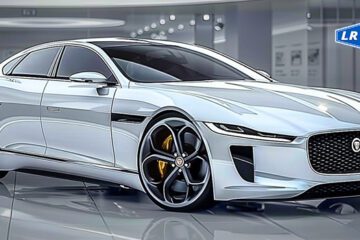Introduction:
Modern automotive brilliance goes beyond raw horsepower, it’s about smart, efficient performance. In response to environmental problems, automakers are transforming combustion engine technology to meet greener benchmarks. This is evident in the latest Jaguar E-PACE Engine, a true wonder of engineering that balances raw performance with stringent emission regulations. Jaguar has successfully built a driving machine that does not sacrifice on excitement while guaranteeing compliance with the world’s toughest pollution laws.
The Jaguar E-PACE represents more than just a compact, opulent SUV. It’s a show of Jaguar’s engineering prowess, particularly in the design of petrol and diesel engines. Discover how the Jaguar E-PACE engine, in both variants, reduces environmental effects while preserving Jaguar’s signature performance.
Emission Challenges for Modern Engines
Today, automakers are under pressure to minimize carbon footprints, with increasingly restrictive emission norms across continents. Stringent emissions standards like Euro 6 in Europe and EPA Tier 3 in the U.S. now require notably cleaner engine combustion. This forces manufacturers to improve every element of engine design.
The aim of the Jaguar E-PACE Engine was clear: Deliver powerful performance while cutting emissions. Achieving this required accurate calibration, intelligent software, and new hardware, specifically in its petrol and diesel versions.
Precision Engineering: The Key to Jaguar’s Success
The Jaguar E-PACE Engine is part of Jaguar Land Rover’s Ingenium family, an in-house line of engines that merge performance and efficiency. These engines aren’t just potent, they’re also modular and scalable. This enables Jaguar to fine-tune them to meet different market-specific emissions laws without reinventing the wheel.
Both the petrol and diesel engines are based on all-aluminium materials. Lightweight materials lessen engine mass and increase efficiency. Less weight means the engine works smarter, not harder. This directly translates into lower fuel consumption and cleaner tailpipe emissions.
Petrol Power: More Than Just Speed
The petrol Jaguar E-PACE Engine has the latest turbocharged 2.0-litre four-cylinder engines, available in different tuning levels depending on the model. But under all those variations lies a common principle: Maximize efficiency without sacrificing power.
Jaguar uses high-pressure direct fuel injection to ensure accurate delivery of fuel into the combustion chamber. This enables the engine to run leaner, minimizing wasted fuel and decreasing the formation of hydrocarbons. The result is clean combustion with very few byproducts.
An outstanding feature is variable valve timing, which adjusts the engine’s air-fuel mix on the fly. At low loads, the engine enhances efficiency. At higher loads, it opens up for more airflow, unlocking that Jaguar-level performance. Due to this dynamic flexibility, the petrol-powered Jaguar E-PACE Engine feels responsive across all driving conditions.
Gasoline Particulate Filters: Clean Air, Uncompromised Power
Another quiet achiever in the petrol engine’s emission control is the Gasoline Particulate Filter (GPF). It captures microscopic particles generated during combustion. Jaguar has boosted the GPF to work efficiently even during cold starts and short drives, when emissions tend to spike.
Remarkably, this doesn’t restrict power output. The GPF is meticulously integrated to maintain exhaust backpressure within ideal limits, guaranteeing that the Jaguar E-PACE Engine persistently delivers a punchy, turbocharged performance while reducing harmful emissions.
The Latest ECU Mapping: Brains Behind the Brawn
Jaguar’s Engine Control Unit (ECU) software is among the most advanced in the industry. The ECU in the Jaguar E-PACE petrol engine controls fuel injection, ignition timing, turbo boost, and even valve timing to confirm every combustion event is improved for emissions and power.
Actual observing of sensors enables micro-adjustments within milliseconds. The ECU even adjusts to different driving conditions, guaranteeing clean combustion even if you’re in city traffic or accelerating on the highway.
The result is a petrol Jaguar E-PACE Engine that not only meets global emissions benchmarks but often surpasses them, without a hint of performance loss.
Diesel Excellence: Refinement Meets Responsibility
Diesel engines have often experienced criticism for their emissions, but the diesel Jaguar E-PACE engine is rewriting that story. Due to Jaguar’s latest diesel technology, the E-PACE diesel variant is cleaner than ever.
The 2.0-litre four-cylinder Ingenium diesel engine comes in various power outputs, but all share one mission: Maximize torque, minimize emissions.
The secret depends on low-friction engine design, optimized fuel injection, and exemplary after-treatment systems. Jaguar’s diesel E-PACE is not only effortless and quiet but also incredibly clean.
Turbocharged Diesel Dynamics with Low Emissions
A defining characteristic of the diesel Jaguar E-PACE Engine is its use of variable-geometry turbochargers. These latest systems adjust the turbine geometry to match engine speed and load. This helps to minimize turbo lag and enhances combustion efficiency, leading to better fuel economy and lower NOx emissions.
Moreover, Jaguar’s diesel engine uses a low compression ratio to confirm a cooler combustion process. Cooler combustion produces fewer nitrogen oxides (NOx), one of the most problematic diesel emissions.
Exhaust After-Treatment: Scrubbing Every Molecule
The E-PACE diesel shows Jaguar’s dedication to cleaner driving, featuring a suite of innovative after-treatment technologies to minimize emissions. One of the most essential is Selective Catalytic Reduction (SCR).
SCR injects urea-based AdBlue fluid into the exhaust stream, converting harmful nitrogen oxides into harmless nitrogen and water vapor. This process takes place in a dedicated catalyst chamber, meticulously tuned for flow and temperature to guarantee complete reaction before tailpipe emission.
Working with SCR technology, the Diesel Particulate Filter (DPF) helps keep the air cleaner by capturing soot before it exits the exhaust.. Jaguar’s DPF system contains automatic regeneration, where the filter is periodically cleaned by burning off collected soot, thus guaranteeing no performance or emissions penalty over time.
Mild Hybrid Systems: Boosting Efficiency
Both the petrol and diesel models of the Jaguar E-PACE Engine offer Mild Hybrid Electric Vehicle (MHEV) technology in specific trims. These systems use a 48-volt battery and a combined starter-generator to capture braking energy and support the engine during acceleration.
By experiencing the engine of certain loads, the MHEV system enables cleaner combustion and lessens fuel consumption. When coasting or braking, the system recuperates energy, effectively minimizing the engine’s workload.
The MHEV system is smart, invisible in operation, and has zero influence on driving excitement. What it does offer is an actual reduction in CO2 and particulate emissions, making the E-PACE even greener.
Cold Start Management: Clean from the First Turn
Cold starts are a surprisingly notable but often ignored contributor to vehicle emissions. Jaguar has invested heavily in thermal management systems that bring the engine up to operating temperature immediately. This includes split cooling circuits, electronically controlled water pumps, and the latest exhaust insulation.
A faster warm-up means emission control systems activate sooner, minimzing the duration of high-emission operation. In petrol and diesel Jaguar E-PACE Engines, emissions are minimized from the moment the engine turns over.
Aerodynamics, Transmission & Emissions
Jaguar hasn’t stopped at the engine; its engineers have also improved aerodynamic efficiency to reduce drag and ease engine strain. A polished body means the engine doesn’t have to work as hard to maintain speed. Lower engine load equals better fuel economy and fewer emissions.
The automatic transmissions mated to the Jaguar E-PACE Engines are finely tuned for smooth gear changes and ideal RPM ranges. This contributes to better combustion, minimized stress on the engine, and more efficient catalytic converter operation.
Actual Driving Emissions (RDE) Compliance
One of the most incredible features of the Jaguar E-PACE Engine range is that they’re not just clean in lab tests, they’re clean on the road. Jaguar’s engines meet RDE2 compliance, which means they pass actual driving tests using portable emissions observing equipment.
This guarantees that the emissions reductions are not just theoretical. Even if you’re driving through urban traffic, highways, or back roads, the Jaguar E-PACE Engine keeps emissions in check, without throttling back power.
The E-PACE Driving Experience
Emissions controls may have transformed, but Jaguar’s unmistakable soul remains untouched. The E-PACE still offers crisp throttle response, a linear torque curve, and a suitable engine growl. Even if you’re driving the petrol or diesel variant, you’ll never feel like you’re compromising fun for eco-friendliness.
The E-PACE petrol models provide brisk acceleration and a refined, zippy character, ideal for city and highway driving. The diesel variants, meanwhile, offer torque-rich performance, exemplary for long-distance cruising and fuel economy.
Jaguar’s Engineering Philosophy
At the core of the Jaguar E-PACE Engine development is a philosophy that clean can be thrilling. Jaguar ignores to trade between excitement for compliance. Instead, it leverages engineering innovation, the latest materials, and advanced software to deliver both.
This is what sets the Jaguar E-PACE Engine apart from contenders. It’s not a compromise; it’s a new standard.
Future-Proof and Road-Ready
Jaguar isn’t just meeting today’s emissions benchmarks; it’s preparing for tomorrow’s. With updates to the Ingenium engine range, a combination of hybrid systems, and ongoing software upgrades, the Jaguar E-PACE Engine will remain compliant and competitive for years to come.
Customers considering investing in the E-PACE are not only getting a stylish and dynamic SUV, but also a vehicle that shows the future of responsible performance. Every drive is a statement, power and sustainability can coexist.
Conclusion:
In a world that needs environmental responsibility, the Jaguar E-PACE Engine proves that you don’t need to give up performance to be clean. Even if you opt for the petrol or diesel variant, you’re stepping into a vehicle designed with both power and purpose.
From advanced turbocharging to smart hybrid tech and world-class after-treatment systems, Jaguar has redefined what it means to drive green. No other engine in its class provides this level of clean-burning excitement, making the E-PACE a true leader in its class.
For those who want the exemplary balance between performance and emission control, the Jaguar E-PACE Engine is the answer. And when it comes to keeping your Jaguar in ideal condition, trust the specialists at LR Engine Specialists, where passion meets precision.
FAQs:
How does the Jaguar E-PACE engine reduce emissions without losing power?
It blends turbocharging, direct fuel injection, variable valve timing, and advanced ECU mapping to guarantee high performance with low emissions.
What emission technologies are used in the diesel E-PACE?
The diesel engine has SCR (AdBlue), DPF with auto-regeneration, and variable-geometry turbochargers for cleaner combustion and reduced NOx.
What role does the Mild Hybrid System play?
The 48V MHEV captures braking energy and supports the engine during acceleration, boosting fuel efficiency and cutting CO₂ emissions.
Is the Jaguar E-PACE compliant with actual emissions standards?
Yes, it meets RDE2 standards, proving low emissions not just in labs but under actual driving conditions.
Does emission technology affect driving performance?
Not at all, Jaguar’s systems are designed to be smooth, preserving the brand’s signature performance and dynamic driving feel.


